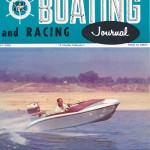What's the Difference Between "Drawing" and "Designing" a Boat?
Posted by Glen Witt on Mar 12th 2013
Most anyone can draw a boat; designing one takes a lot more effort and ability.
Of primary importance in designing a small boat is knowledge gained by experience. At GLEN-L we design boats, build testing prototypes, and then test the in-water performance. Most designers don't have the luxury of being able to test their final product. We do and the experience gained is invaluable for designing future craft.
A new design is started by establishing the parameters. The length, beam, depth, and type of boat is decided on; power or sail and the material the boat is to be built from must be selected. Every boat is a compromise and practical experience dicatates the inevitable give and take features that are best for the particular craft being designed.
 Designers use coefficients that provide comparative
factors to determine the general shape of the midsection and other factors. The
range of coefficients for a given type of boat have been gathered over the
years and are given in books on boat design. But a designer's experience of the
performance of previous boats is used to temper the figures, as little
information has been published on smaller boats.
Designers use coefficients that provide comparative
factors to determine the general shape of the midsection and other factors. The
range of coefficients for a given type of boat have been gathered over the
years and are given in books on boat design. But a designer's experience of the
performance of previous boats is used to temper the figures, as little
information has been published on smaller boats.
The basic lines of the boat are developed showing three views; plan, profile, and sections. A designer must rough out a set of lines that hopefully match the desired coefficients. The term hopefully is used because accurate coefficients cannot be determined until the lines are finalized.
The displacement of the boat must be estimated; this is the total weight of the hull, motor, passengers, and everything on board when the boat is on the water. Then an estimated waterline is sketched on the lines.
A boat will displace a weight of water equal to its displacement. The underwater volume can be calculated by determining areas of equally spaced sections ("s") and entering them into Simpsons 1/3 Rule formula; boat design computer programs do it quicker. The calculated displacement should be very close to the one estimated. If not, back to the drawing board to raise or lower the waterline or adjust the lines and recalculate displacement.
A boat has a balance point called center of buoyancy (CB) that is comparable to the pivot point on a teeter totter. The CB can be determined by using figures obtained from Simpsons Rule; the volume on either side of the CB must be equal. But the CB must be located at the ideal position to carry the loadings. The approximate desireable location of the CB is obtained from published figures or percentages of the waterline length gained by experience. The CB is virtually always aft of the mid-points of the waterline length. If the calculated CB is not within the design parameter it's back to square one and modification of the lines.
 Glen L. Witt, Naval Architect at work
Glen L. Witt, Naval Architect at work
But the designer isn't finished. Weights have been estimated and must be finalized. The weight of every component of a boat must be calculated and it's distance from the CB noted. Consider what is involved. A wooden boat may have a 1¼" x 3½" keel 18' long. The volume of the member times the weight of the wood for a given volume is calculated and the center of that weight in relationship to the CB determined. And this is done for everything that will be in the boat. If the total weight isn't equal or close to the displacement or the weights are not equally distributed about the CB, modifications will be necessary. An experienced designer gets an "eye" or "feel" for a set of lines and can usually finalize a set of lines with minimal revisions. A neophyte designer may spend days or weeks bringing all of the factors into balance.
A sailboat will need to be balanced so it will sail properly without lee or weather helm. Rudder area must be calculated to provide good steering and the keel or centerboard determined to provide directional stability If a boat is towed sideways through the water so the longitudinal centerline of the hull is perpendicular to the towing line that point on the waterline is called the center of lateral resistance or CLR. The combined area of the sails must be positioned about the CLR properly (called "lead") to assure balance. And of course the sail area forces must be balanced with adequate ballast so the boat will not capsize.
Powerboats will require calculations on the most desireable horsepower based on the hull characteristics. If the hull is a semi displacement type, with limited speed potential, it doesn't make sense to overpower the boat. Conversely underpowering a planing hull will make a boat a real dog.
 Some of the information necessary to make the many
calculations are given in design textbooks. Other factors are obtained through
technical writings and papers collected by a designer over the years. And if
you test boats as we do at GLEN-L, parameters that work can be applied to
future designs.
Some of the information necessary to make the many
calculations are given in design textbooks. Other factors are obtained through
technical writings and papers collected by a designer over the years. And if
you test boats as we do at GLEN-L, parameters that work can be applied to
future designs.
Most creditable designers have a background of engineering or schooling on boat design through universities and specialized boat design courses. Schooling covering the design of smaller craft however is almost non-existant and the experience gained through testing prototypes is invaluable on this size craft.
The foregoing outlines the general procedure that must be gone through to design as opposed to drawing a boat. Computers can do many of the calculations. However, a computer can't design a boat. Someone must put in the figures to form the boat and use the knowlege to select the proper parameters. It's been stated that designing a good looking, well performing boat, is a combination of engineering and art and the best way to develop this combination is through experience. And with more than 60 years of designing boats GLEN-L has experience plus.
- BOOKS:
- YACHT DESIGNING AND PLANNING, by Howard Chapelle ($35.00)
- SCHOOLS:
- Westlawn Institute of Marine Technology733 Summer StStamford, CT 06901203-359-0500
- Computer programs:
- PLYBOATS 2.01Ray Clark Enterprises7071 Warner Ave., #FHuntington Beach, CA 92647email: plyboats@ido.net
